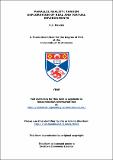Files in this item
Parallel reality : tandem exploration of real and virtual environments
Item metadata
| dc.contributor.advisor | Miller, Alan Henry David | |
| dc.contributor.author | Davies, C. J. | |
| dc.coverage.spatial | 264 | en_US |
| dc.date.accessioned | 2016-01-29T16:07:19Z | |
| dc.date.available | 2016-01-29T16:07:19Z | |
| dc.date.issued | 2016-01-18 | |
| dc.identifier | uk.bl.ethos.678194 | |
| dc.identifier.uri | https://hdl.handle.net/10023/8098 | |
| dc.description.abstract | Alternate realities have fascinated mankind since early prehistory and with the advent of the computer and the smartphone we have seen the rise of many different categories of alternate reality that seek to augment, diminish, mix with or ultimately replace our familiar real world in order to expand our capabilities and our understanding. This thesis presents parallel reality as a new category of alternate reality which further addresses the vacancy problem that manifests in many previous alternate reality experiences. Parallel reality describes systems comprising two environments that the user may freely switch between, one real and the other virtual, both complete unto themselves. Parallel reality is framed within the larger ecosystem of previously explored alternate realities through a thorough review of existing categorisation techniques and taxonomies, leading to the introduction of the combined Milgram/Waterworth model and an extended definition of the vacancy problem for better visualising experience in alternate reality systems. Investigation into whether an existing state of the art alternate reality modality (Situated Simulations) could allow for parallel reality investigation via the Virtual Time Windows project was followed by the development of a bespoke parallel reality platform called Mirrorshades, which combined the modern virtual reality hardware of the Oculus Rift with the novel indoor positioning system of IndoorAtlas. Users were thereby granted the ability to walk through their real environment and to at any point switch their view to the equivalent vantage point within an immersive virtual environment. The benefits that such a system provides by granting users the ability to mitigate the effects of the extended vacancy problem and explore parallel real and virtual environments in tandem was experimentally shown through application to a use case within the realm of cultural heritage at a 15th century chapel. Evaluation of these user studies lead to the establishment of a number of best practice recommendations for future parallel reality endeavours. | en_US |
| dc.language.iso | en | en_US |
| dc.publisher | University of St Andrews | |
| dc.rights | Creative Commons Attribution-NonCommercial-NoDerivatives 4.0 International | |
| dc.rights.uri | http://creativecommons.org/licenses/by-nc-nd/4.0/ | |
| dc.subject | Parallel reality | en_US |
| dc.subject | Cross reality | en_US |
| dc.subject | Virtual reality | en_US |
| dc.subject | Augmented reality | en_US |
| dc.subject | Mixed reality | en_US |
| dc.subject | Alternate reality | en_US |
| dc.subject | Indoor positioning system | en_US |
| dc.subject | Presence | en_US |
| dc.subject | Virtual experience | en_US |
| dc.subject | Head mounted display | en_US |
| dc.subject | Oculus Rift | en_US |
| dc.subject | Mirrorshades | en_US |
| dc.subject | Cultural heritage | en_US |
| dc.subject | St Salvator's Chapel | en_US |
| dc.subject.lcc | QA76.9H85D28 | |
| dc.subject.lcsh | Mixed reality | en_US |
| dc.subject.lcsh | Indoor positioning systems (Wireless localization) | en_US |
| dc.subject.lcsh | Cultural property--Data processing | en_US |
| dc.title | Parallel reality : tandem exploration of real and virtual environments | en_US |
| dc.type | Thesis | en_US |
| dc.contributor.sponsor | Engineering and Physical Sciences Research Council (EPSRC) | en_US |
| dc.type.qualificationlevel | Doctoral | en_US |
| dc.type.qualificationname | PhD Doctor of Philosophy | en_US |
| dc.publisher.institution | The University of St Andrews | en_US |
This item appears in the following Collection(s)
Except where otherwise noted within the work, this item's licence for re-use is described as Creative Commons Attribution-NonCommercial-NoDerivatives 4.0 International
Items in the St Andrews Research Repository are protected by copyright, with all rights reserved, unless otherwise indicated.


